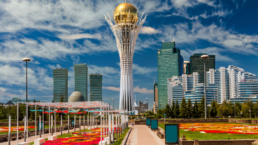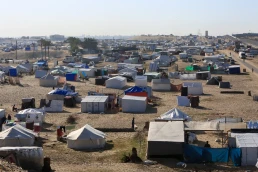A conversation with Togzhan Kassenova about how Kazakhstan became a world leader in nuclear disarmament
By Jon Letman, Outrider
Between 1949 and 1989, the Soviet Union conducted at least 450 nuclear tests in Kazakhstan. In doing so, it spread nuclear contamination across an area five times larger than New York’s Long Island.

Over four decades, the USSR detonated more than 17 megatons (a yield greater than one thousand Hiroshima-sized bombs) at the Polygon nuclear test site, just 75 miles from Semipalatinsk, a city of 120,000. Not only did testing cause widespread environmental damage, it led to dramatically elevated rates of cancer, abnormal fetus development, miscarriages, and an epidemic of suicides among people living near the site.
But just as the Soviet Union was breaking apart, the people of Kazakhstan had embarked on a grassroots movement weaving denuclearization and the quest for national independence into an international effort with other nuclear-affected peoples.
The extraordinary story of how Kazakhstan transformed itself from a nuclear testing ground and home to the world’s fourth largest nuclear arsenal into an independent, nuclear-free global leader in denuclearization is told in Atomic Steppe: How Kazakhstan Gave up The Bomb by Togzhan Kassenova.
Kassenova, a senior fellow at the University of Albany, SUNY, and a nonresident fellow in the Nuclear Policy Program at the Carnegie Endowment for International Peace, spoke with Outrider about her book.
Recent Posts
Stop Israel’s Dystopian “Humanitarian City” Plan—Before It’s Too Late
July 11, 2025
Take Action Now For the past 20 months, the world has watched—and largely enabled—a genocidal campaign in Gaza. Over 55,000 Palestinians have been…
The “Liberal” International Order Is Criminalizing Palestine Protests
July 11, 2025
Take Action Now As Western governments repress Palestine solidarity and enable Israel’s impunity, the “liberal international order” is no longer…
Politicians Are Betraying Gen Z On Climate
July 10, 2025
Take Action Now While Gen-Zers thrift, knit, crochet, and find other ways to reduce our footprints, Trump and the GOP are greenlighting more climate…
Trump’s Deportation Threat Against Zohran Mamdani Is Shameful
July 10, 2025
Take Action Now In only half a year of Donald Trump’s presidency, he and his allies have turned deportation into an explicitly political threat…




